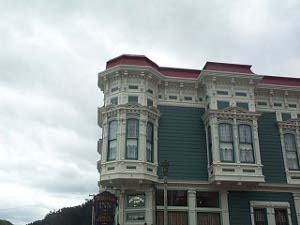 The Lost Coast
passed a herd of Roosevelt elk in a pasture. These animals had died out and are being reintroduced in this location.
The Lost Coast
passed a herd of Roosevelt elk in a pasture. These animals had died out and are being reintroduced in this location.
Heading north from Fort Bragg we followed the coast and then turned inland to the large preserves of old growth coast redwoods. The Save the Redwoods League was founded around 1920s, and a patchwork of memorial groves has since been combined into at least nine different state parks and one national park. We got off the 101 freeway and drove the Avenue of the Giants; the average redwood lives for 600 years, and the oldest 2000. We're glad that these trees will be saved for posterity instead of falling victim to the lumberman's axe. There's still plenty of redwood for building and for chainsaw sculptures of bears! We  The Lost Coast
passed a herd of Roosevelt elk in a pasture. These animals had died out and are being reintroduced in this location.
The Lost Coast
passed a herd of Roosevelt elk in a pasture. These animals had died out and are being reintroduced in this location.
Northwestern California is isolated by rugged coastal mountains, and was slow to develop. It's known as California's Lost Coast, and we took a loop drive on Mattole Road to explore it. We first climbed switchbacks to a wintry 2700-foot pass. The noonday temperature dropped to 36 degrees at the summit, and there was still a lot of packed snow on the road; it would be dangerous at night.
As we descended the equally steep west side the snow stopped at about 1000 feet and the temperature rapidly rose to 54. Our National Geographic Scenic Highways guide advised us to stop at Honeydew and gab with the grizzled old men drinking beer on the porch of the general store, but we didn't. The road followed the Mattole River valley to the ocean, with small farms and ranches. We enjoyed waving at oncoming drivers, most of whom returned the gesture. Snow lay in patches along the hillsides and covered the tops of the higher mountains.
There followed a stretch of road next to the ocean, with no tourist facilities, just some cattle ranches next to the empty dunes and beaches. Then  Ferndale architecture
there was Cape Mendocino, the site of numerous shipwrecks. Offshore there was a rock and on the rock a flagpole, about thirty feet high. With the binoculars we could see a U.S. flag wrapped around the pole and fluttering in the stiff breeze. We wondered who put it there. We spotted a plaque, placed by E Clampus Vitus, commemorating the Cape Mendocino lighthouse.
Ferndale architecture
there was Cape Mendocino, the site of numerous shipwrecks. Offshore there was a rock and on the rock a flagpole, about thirty feet high. With the binoculars we could see a U.S. flag wrapped around the pole and fluttering in the stiff breeze. We wondered who put it there. We spotted a plaque, placed by E Clampus Vitus, commemorating the Cape Mendocino lighthouse.
The Mattole Road became even more spectacular, snaking up the huge hill at Cape Mendocino and following a coastal ridge north to the town of Ferndale, whose Main Street is lined with Victorian facades. We were back in civilization. Ferndale was originally a creamery town and still has a working dairy company, but its emphasis is on tourism. We enjoyed a late lunch at a Victorian hotel, where the sandwiches were served on Fiestaware plates, and each table had its own novelty salt-and-pepper shaker: ours was a dapper bartender holding a cocktail shaker; another was a frog in a chair.